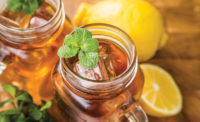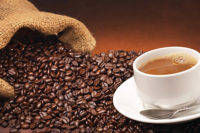Millions of Americans can’t be wrong. And what is it that we are not wrong about? Our choice in beverages, that’s what. According to “Coffee and Tea Foodservice Trends in the US” (a report from Packaged Facts), fully 183 million Americans enjoy their regular infusions of java and 173.4 million take tea.
What makes tea and coffee so exciting for the dairy crowd is not just their popularity as drinks, but their potential as ingredients in everything from fanciful bubble teas to matcha frozen yogurt and espresso ice cream. We convened a virtual roundtable of suppliers (see box) who talked about trends, flavor science, nutrition news and innovations.
Dairy Foods: We’re dairy processors here. Why should we care about tea and coffee?
John Wilson: Dairies have processing and distribution channels already in place through their fluid milk channel. This makes dairies particularly well suited to entering the coffee and tea market.
Jessica Jones-Dille: Many dairies also produce coffee and tea products, both in single-serve and multi-serve packaging. Consumers continue to desire varied choices for both at-home and on-the-go beverage consumption, so being able to offer more versions of these products — especially flavored and even vitamin fortified — will be important to shoppers.
Marc Andros: Most coffee drinkers use some form of dairy to modify their coffee. In addition, milk-based beverages are continuing to grow in popularity. This has led to a younger demographic drinking milk-based coffee beverages, as well as to a widening of the traditional demographic beyond regular coffee drinkers. And RTD [ready-to-drink] coffee beverages, in which the primary ingredient is milk, are becoming a popular, alternative in-home beverage.
Dairy Foods: Beverages are getting a lot of attention. But where else are we seeing tea and coffee, besides in people’s mugs, cups and bottles?
Greg Robertson: Teas and coffees are flavoring spoonable and drinkable yogurts and healthy smoothies, ice creams, gelatos, dips and spreadable cheeses and, in their most exotic expressions, dairy-based sauces and soups.
Peggy Pellichero: I have seen frozen desserts, ice creams and cheesecake desserts using teas and fruits, or coffee and chocolate combinations.
Heather Biehl:Some product examples include energy beverages, smoothies, yogurts, juice drinks, shots, enhanced waters, nutritional bars, gummies/pectins, effervescent tablets and dry drink mixes.
Paulette Haber: Tea has also entered the spirits and cocktail sector of the beverage market. But now we see tea migrating to many food categories. Tea flavors have long been featured in ice cream. We are now seeing tea flavors in items from green tea breath mints to chocolate candies. Other applications for tea flavors include sorbet and frozen novelties.
Dairy Foods: Before we dive deeper into flavor trends, help us understand the factors that influence tea and coffee flavor in the first place.
Steve Wolf: First are agricultural conditions, which include issues such as weather conditions throughout the growing season and the altitude of a particular farm or plantation. Second is the post-harvest processing, as both tea and coffee undergo a fermentation step after being harvested. Differences in fermentation methods are what differentiate green tea and black tea, as the leaves are sourced from the same plant variety.
Youngmok Kim: There are four different kinds of real tea: white tea, green tea, oolong tea and black tea. They all come from one tea leaf, but they are different because their processing method is different. Green tea is immediately dried after harvest, so green tea contains more caffeine. Black tea is fermented after harvest, so during fermentation, the caffeine levels decline, which is why black tea contains less caffeine.
Kevin Goodner:But when we talk about tea fermentation that does not mean a microbiological fermentation. It’s an oxidative process that’s termed “fermentation.”
Ana Gumabon:Bean or leaf variety has a big effect on flavor. For example, depending on desired flavor, manufacturers using coffee will specify the variety of coffee bean and whether a pure variety or combination is preferred for the application. Coffee and tea experts know that the aromatic profiles not only depend on the varieties of the bean or leaf, but also where these are grown.
Stacy DeMars:We can create a multitude of flavors using coffee beans and tea leaves not only by changing the bean or tea cultivar blend but by changing roasting conditions for coffee or fermentation conditions for tea, the extraction techniques, temperature, solvent and grind size.
Dairy Foods:That’s a really complex interaction of provenance and process. So how is this playing out in tea and coffee trends?
Douglas Rash:At the high end of the market, customers are looking for more exotic and rare origins of tea and coffee, especially those with an appealing back story related to fair trade, organic production [and] green sustainability. In the mainstream, there is clearly demand for higher quality in the beverages that people drink every day. The success of Starbucks and others has led coffee drinkers to demand more boldly roasted coffees; this tends to erase the flavor subtleties associated with origin.
Dairy Foods: What other new blends or types of tea and coffee are consumers seeking?
Paul Altaffer: Tulsi tea — also known as holy basil — is an important ayurvedic tea from India similar in therapeutic affects to ginseng tea but with a desirable flavor. Honeybush from Africa is a sister of rooibos but sweeter. Hibscus tea is popular in Central America and also has known health benefits. Popular South American teas include yerba mate and guayusa — same genus as yerba mate, different species. Both contain naturally occurring caffeine.
Dairy Foods:Of course, the one tea/coffee trend we haven’t mentioned yet is the 1,000-pound gorilla: health and wellness. How big a factor is it in the drinks’ popularity?
John Harper Crandall: Recently, consumers searching for simple ways to improve their diets have been eliminating soft drinks, but still search for refreshment and taste satisfaction. Coffee and especially tea-based beverages are perceived as natural and healthy, and both market segments have been growing steadily as consumers make the switch. Antioxidants, hydration, replenishment: people already connect these words with tea, so just having the word “tea” on the label adds an air of healthy to the product.
Angela Lantman: Tea is continuing the trend of being healthier than carbonated sodas, with typically less sugar and the benefit of antioxidants and polyphenols. It’s not necessarily a new trend, but it’s certainly continuing to move in that direction.
DeMars: There have been numerous studies showing how coffee provides healthful benefits and can aid in weight loss and reduce the risk of diseases including diabetes, Parkinson’s and colon cancer. Green tea is the least processed and thus provides the most antioxidant polyphenols. Green tea drinkers appear to have lower risk for a wide range of diseases, from simple bacterial or viral infections to chronic degenerative conditions including cardiovascular disease, cancer, stroke, periodontal disease and osteoporosis.
Biehl: Both tea and coffee have similar constituents, with the main health benefits coming from polyphenols and caffeine. Tea polyphenols include catechins like epigallocatechin gallate, or EGCG, which are most commonly studied for their cholesterol-reduction and weight-management benefits. Tea also contains many free amino acids like theanine. Coffee contains polyphenols such as chlorogenic acids that are most recently studied for their effects on diabetes and metabolic syndrome.
And for coffee, who can ignore the recent buzz about the benefits green coffee has on weight loss?
The most interesting finding to me regarding tea is its benefit for dental health. There have been some studies showing that consuming tea is associated with reduced cavities. Polyphenols in tea also help to destroy bacteria in the mouth that cause bad breath, gum disease and tooth decay.
Dairy Foods:So if we want to incorporate these health benefits — along with the tea and coffee themselves — into dairy products, what are some of the challenges we face?
Lantman:One of the challenges we face especially is astringency. Yet you often don’t want to use sugar to cover up that astringency. Finding the right flavor balance involves a little bit of science and a little playing around, like you would do in your own kitchen. You would look more toward sweet flavors — vanilla, caramel, things like that. But citrus notes can actually enhance the astringency. Tea and coffee also typically taste better at a slightly higher pH: between 4 and 5. So they complement milk-based products like ice creams, but tea and coffee tend to get a little fruity and have some off-notes when you put them in yogurt or a very acidic environment.
Markus Eckert: Coffee’s taste and flavor are on the bitter, sour and phenolic side of the spectrum, so sweet brown flavors like caramel, vanilla and chocolate (but also phenolic and smoky pyrazine flavors such as nut flavors, tea, smoke, barbecue, et cetera) work well with coffee.
Dairy Foods:What ingredient options do dairy manufacturers have for incorporating tea and coffee into their products?
Biehl: There are some excellent beverage delivery systems for tea and coffee ingredients. Extraction technology can isolate the healthy components from tea and coffee and leave behind any undesirable insoluble material and flavor. And having tea and coffee’s health benefits without tasting like tea and coffee allows for broader application use. Taste modifiers also work well for masking bitterness and astringency often associated with tea and coffee.
Gumabon:Coffee and tea can easily be added to dairy products in various forms: powder, liquid extract, crushed dried leaves and as a sweetened concentrated base. Normally, tea or coffee solids are derived by aqueous extraction and then dried. Both cold and hot water-soluble powders are available. Liquid extracts are normally extracted using hot water. The time and temperature that the tea or coffee solids are exposed to will affect the final flavor. This liquid form is advantageous for easy dispersion and dilution.
The tea or coffee ingredient in powdered or extract form can then be put into a sweetened and/or stabilized blend. A sweetened base is an easier way of incorporating coffee or tea ingredients. The base can be formulated to be thin or thick depending on the application and can have additional coffee or tea flavors or essences to enhance the overall flavor. A sweetened base can also provide a buffering effect when added to high-acid dairy products such as yogurt.
Wolf:For traditional RTD teas, [a unitized tea blend] contains instant tea powder and flavors, and often everything else a dairy processor will need, with the exception of water and sweeteners. This allows the tea ingredients to be stored at room temperature, and insures a consistent and microbiologically safe ingredient. It also contains tea solids with some of the non-volatile tea components necessary for true tea impact.
Dairy Foods: What tips can you share for working with these ingredients and achieving optimum stability — of the flavor, the health benefits and the entire product?
Gumabon: Powder needs to be incorporated under high agitation or premixed with water (if water-soluble) or with a high-solids ingredient such as sugar to prevent caking. A liquid coffee or tea extract will probably be easier to work with. Dehydrated crushed tea leaves will probably be harder to incorporate into dairy products without affecting texture and appearance undesirably.
Jeff Foss: The acidity that these ingredients bring can lower the pH of the dairy product and cause flocculation under high heat. Therefore, the product must be buffered. Additionally, emulsions can break in some processing conditions causing cream ringing in the end product. Gums, pH sequestering agents and good homogenization practices can help overcome processing challenges.
Marie Cummings:Coffee affects the stability of a dairy beverage, and it is suggested to use potassium citrate as a buffer to prevent the protein from denaturing during the heating process.
Biehl:It’s important to mention that there have been studies looking at tea and milk interactions. Large-molecular-weight polyphenols such as catechins present in tea can bind with protein found in milk. This binding may affect their functionality and bioavailability. Research is not conclusive, but the point deserves further exploration.
Dairy Foods: In the end, what’s the key to developing and producing a really stellar tea or coffee product?
Scott Geringer:An advantage of using real tea and coffee extracts in dairy is the ability to label the flavor ingredient “brewed.” The brewed descriptor has resonance with consumers. From a product sensory standpoint, using real tea and coffee provides for the optimal aroma delivery system. Perceived natural aroma is just as critical as flavor when it comes to the consumer experience.
Altaffer:The answer to this is simple: Trash in, trash out. Understanding what good quality is, and understanding how to buy good quality ingredients, is key. If you have a bad-quality tea, it will be reflected in the final ingredient or product. N
Meet the panel of 20 experts
• Paul Altaffer, vice president of business and product development, RFI Ingredients, Blauvelt, N.Y.
• Marc Andros, business development director, coffee, Kerry Ingredients & Flavors, Beloit, Wis.
• Heather Biehl, manager, health ingredients, Wild Flavors, Cincinnati
• John Harper Crandall, vice president of sales, Amelia Bay, John’s Creek, Ga.
• Marie Cummings, manager of food applications and product development, David Michael & Co., Philadelphia
• Stacy DeMars, marketing coordinator, Autocrat, Lincoln, R.I.
• Markus Eckert, senior vice president, R&D, beverage systems & flavors, Kerry Ingredients & Flavors, Beloit, Wis.
• Jeff Foss, principal scientist, Wild Flavors, Cincinnati
• Scott Geringer, vice president, extracts and ingredients, S&D Coffee and Tea, Concord, N.C.
• Kevin Goodner, director of R&D, Synergy Flavors, Wauconda, Ill.
• Ana Gumabon, director of research & development, California Custom Fruits & Flavors Inc., Irwindale, Calif.
• Paulette Haber, director, marketing communications and research, Virginia Dare, Brooklyn, N.Y.
• Jessica Jones-Dille, associate director, marketing, Wild Flavors, Cincinnati
• Youngmok Kim, senior scientist, Synergy Flavors, Wauconda, Ill.
• Angela Lantman, applications manager, coffee and tea, Synergy Flavors, Wauconda, Ill.
• Peggy Pellichero, senior food technologist, dairy team leader, David Michael & Co. Philadelphia
• Douglas Rash, group vice president, global sales, Treatt USA, Lakeland, Fla.
• Greg Robertson, president and founder, Teawolf, Pine Brook, N.J.
• John Wilson, marketing manager, Allen Flavors, South Plainfield, N.J.
• Steve Wolf, director of flavor applications, Robertet Flavors, Piscataway, N.J.












